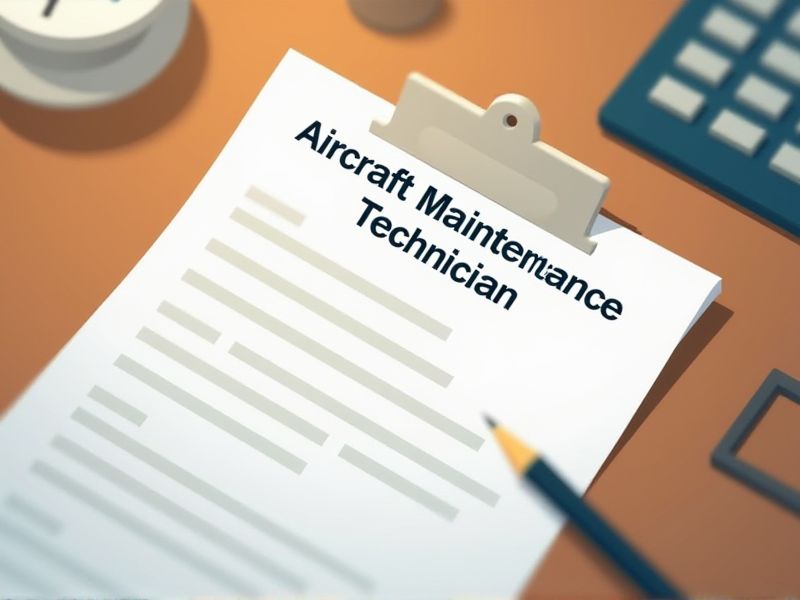
Aircraft Maintenance Technicians play a critical role in ensuring the safety and reliability of aircraft. Certification is crucial as it validates their expertise and adherence to industry standards. Achieving these credentials ensures technicians can competently perform inspections, maintenance, and repairs in accordance with regulatory requirements. Some key certifications you may need for a career as an Aircraft Maintenance Technician include the following.
FAA Airframe and Powerplant (A&P) Certification
The FAA Airframe and Powerplant (A&P) Certification ensures that an Aircraft Maintenance Technician has met strict standards for safety and competency. Without this certification, technicians are not legally authorized to perform maintenance, which could compromise aircraft safety. The certification process demands comprehensive knowledge of federal aviation regulations, confirming the capability to adhere to industry guidelines. The credential boosts trust among employers and operators, leading to better employment opportunities and career advancement in the aviation sector.
EASA Part-66 Aircraft Maintenance License
The EASA Part-66 Aircraft Maintenance License is necessary because it establishes standardized qualifications and competencies for technicians, ensuring they meet European aviation safety standards. This license authorizes technicians to certify and release aircraft back into service, which is vital for operational safety. The license also facilitates employment mobility across EASA member countries, enhancing career opportunities. Compliance with EASA ensures that technicians have updated skills and knowledge to handle evolving aircraft technologies.
Transport Canada Maintenance Engineer (AME) Certification
Transport Canada AME Certification ensures that an Aircraft Maintenance Technician is qualified to conduct maintenance in compliance with Canadian aviation regulations. It establishes a standard of safety and reliability, critical to prevent mechanical failures and potential accidents. Certification acts as a verification of technical skills and knowledge necessary for maintaining complex aircraft systems. Without this certification, an AME cannot legally sign off on maintenance work, essential for the aircraft's return to service.
Avionics Technician Certification
Obtaining an Avionics Technician Certification equips Aircraft Maintenance Technicians with specialized knowledge in managing a plane's intricate electronic systems. This certification ensures adherence to strict safety standards, minimizing the risk of technical malfunctions during flight. It enables technicians to perform precise diagnostics and repairs, reducing aircraft downtime and maintenance costs. Regulatory bodies often mandate such certifications to ensure compliance with industry standards and enhance overall operational efficiency.
Type Rating or Type-Specific Training Certification
Type ratings or type-specific training ensure that aircraft maintenance technicians possess in-depth knowledge specific to the aircraft model they're working on, leading to safer and more effective maintenance. Different aircraft have unique systems and requirements, necessitating specialized training for accurate diagnosis and repair. Without type-specific training, technicians may overlook critical nuances, increasing the risk of system failures and safety hazards. The certification ensures compliance with aviation regulations, thus maintaining industry standards and enhancing overall operational safety.
IATA Dangerous Goods Regulations Certification
The IATA Dangerous Goods Regulations Certification ensures Aircraft Maintenance Technicians understand how to safely handle and store hazardous materials, preventing potential accidents. Without this certification, technicians might inadvertently mishandle dangerous goods, leading to safety risks and regulatory violations. Knowledge from the certification helps maintain compliance with global safety standards, reducing liability for airlines. Proper training in dangerous goods management enhances overall operational safety and efficiency in aircraft maintenance processes.
OSHA Safety Certification
OSHA Safety Certification is essential for aircraft maintenance technicians because it ensures they understand and comply with federal safety regulations. This certification reduces the likelihood of workplace accidents, protecting both technicians and the expensive aircraft they maintain. Knowledge from OSHA training enhances a technician's ability to identify and mitigate safety hazards effectively. Certified technicians contribute to a culture of safety, leading to improved operational efficiency and reduced downtime in the aviation industry.
Lean Six Sigma Certification (Process Improvement)
Lean Six Sigma certification equips aircraft maintenance technicians with tools to identify and eliminate inefficiencies, leading to reduced downtime and cost savings. By applying data-driven analysis, technicians can improve the reliability and quality of aircraft maintenance processes, ensuring higher safety standards. The certification fosters a culture of continuous improvement, critical in the high-stakes aviation industry where precision and reliability are paramount. Increased process efficiency can also result in faster turnaround times, enhancing overall operational effectiveness.
Human Factors and Aviation Safety Certification
Human Factors and Aviation Safety Certification helps Aircraft Maintenance Technicians understand how human error can impact safety, thereby reducing the risk of accidents. This certification equips technicians with the skills to recognize fatigue, communication breakdowns, and situational awareness issues that might compromise maintenance quality. Regulators mandate this certification to ensure consistent safety standards across the aviation industry. Airlines often require it to enhance their maintenance protocols and improve overall operational efficiency.
Aircraft Structures and Systems Training Certification
Aircraft Structures and Systems Training Certification is needed for Aircraft Maintenance Technicians because it ensures they possess the required knowledge to maintain and repair complex aircraft systems effectively. This certification helps in minimizing human error by enhancing technicians' understanding of structural mechanics and system functionalities. Regulatory bodies mandate such certifications to comply with aviation safety standards, thereby reducing risks associated with air travel. The certification also elevates a technician's career by improving job prospects and potential advancements within the aviation industry.
Summary
Gaining certifications as an Aircraft Maintenance Technician enhances your job prospects and secures higher earning potential. With specialized credentials, you demonstrate a commitment to excellence, attracting the attention of employers seeking skilled individuals. Certifications expand your skillset, enabling you to handle complex maintenance tasks more efficiently. Employers often prioritize certified technicians for advanced roles, leading to accelerated career advancement.
